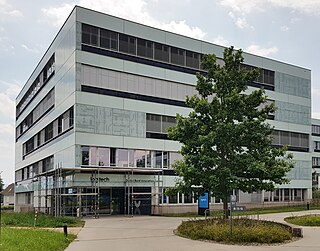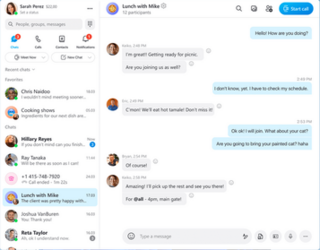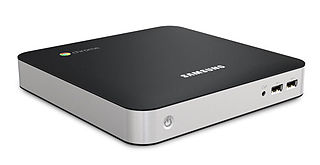Related Research Articles

Logitech International S.A. is a Swiss multinational manufacturer of computer peripherals and software. Headquartered in Lausanne, Switzerland, and San Jose, California, the company has offices throughout Europe, Asia, Oceania, and the Americas, and is one of the world's leading manufacturers of input and interface devices for personal computers (PCs) and other digital products. It is a component of the flagship Swiss Market Index, and listed on the Nasdaq.

Skype is a proprietary telecommunications application operated by Skype Technologies, a division of Microsoft, best known for IP-based videotelephony, videoconferencing and voice calls. It also has instant messaging, file transfer, debit-based calls to landline and mobile telephones, and other features. It is available on various desktop, mobile, and video game console platforms.

InFocus Corporation is a privately owned American company based in the state of Oregon. Founded in 1986, the company develops, manufactures, and distributes DLP and LCD projectors and accessories as well as large-format touch displays, software, LED televisions, tablets and smartphones. InFocus also offers video calling services. Formerly a NASDAQ listed public company, InFocus was purchased by Image Holdings Corp., owned by John Hui, in 2009 and is now a wholly owned subsidiary headquartered in Tigard, Oregon.

Skype for Business Server is real-time communications server software that provides the infrastructure for enterprise instant messaging, presence, VoIP, ad hoc and structured conferences and PSTN connectivity through a third-party gateway or SIP trunk. These features are available within an organization, between organizations and with external users on the public internet or standard phones.

Videotelephony is the use of audio and video for simultaneous two-way communication. Today, videotelephony is widespread. There are many terms to refer to videotelephony. Videophones are standalone devices for video calling. In the present day, devices like smartphones and computers are capable of video calling, reducing the demand for separate videophones. Videoconferencing implies group communication. Videoconferencing is used in telepresence, whose goal is to create the illusion that remote participants are in the same room.

Poly Inc., formerly Polycom, is an American multinational corporation that develops video, voice and content collaboration and communication technology. Poly is a subsidiary of HP Inc.

Scopia, within the computer networking and telecommunications fields, is a series of unified communications products that provide meet-me, videoconferencing and online collaboration. The Scopia products include the Scopia XT Telepresence, Scopia XT7100 Room System, Scopia XT5000 Room System, Scopia XT4300 Room System, SCOPIA XT1000 Piccolo,XT Meeting Center Room System, Scopia Firewall Traversal, Multipoint control units, Gateways, Scopia Control, Scopia Desktop Video Conferencing, and Scopia Mobile HD Video Conferencing. The Scopia products are developed and sold by Avaya and their Business Partner network.
Android is a mobile operating system based on a modified version of the Linux kernel and other open-source software, designed primarily for touchscreen-based mobile devices such as smartphones and tablets. Android has historically been developed by a consortium of developers known as the Open Handset Alliance, but its most widely used version is primarily developed by Google. First released in 2008, Android is the world's most widely used operating system; the latest version, released on October 15, 2024, is Android 15.

Lifesize was a video and audio telecommunications company in the United States which provided high definition videoconferencing endpoints and accessories, touchscreen conference room phones, a cloud-based video collaboration platform, and omnichannel contact center solutions under their CxEngage product line. Lifesize's headquarters was located in Austin, Texas. Its Europe, Middle East and Africa regional office were located in Munich, Germany.

Skype Qik was a video messaging service by Skype. It was created by the company, Skype Technologies, who acquired Qik. The service, offered for Android, iOS, and Windows Phone devices, allowed users to exchange video messages between individuals or within a group.

Google TV was a smart TV operating system from Google co-developed by Intel, Sony and Logitech. It launched in October 2010 with official devices initially made by Sony and Logitech. Google TV integrated the Android 3.0/3.2 operating system and the Google Chrome web browser to create an interactive television overlay on top of existing online video sites to add a 10-foot user interface, for a smart TV experience.

A Chromebox is a small form-factor PC that runs Google's ChromeOS operating system. The first device debuted in May 2012.

Honor Device Co., Ltd., commonly known as HONOR, is a Chinese consumer electronics company majority-owned by Shenzhen Zhixin New Information Technology Co. Ltd. It was formerly a subsidiary of Huawei, who sold the brand in November 2020. Honor develops smartphones, tablet computers, wearables and mobile device softwares.
BlueJeans by Verizon was a company that provided an interoperable cloud-based video conferencing service. It was headquartered in the Santana Row district of San Jose, California. Prior to being acquired by Verizon in 2020, the company was known as "BlueJeans Network" Verizon decided to close down the Blue Jeans platform in August 2023, and closed the website in March 2024.

Zoom Communications, Inc. is a communications technology company primarily known for the videoconferencing application Zoom. The company is headquartered in San Jose, California, United States. The company was founded in 2011 by Eric Yuan, a former Cisco engineer and executive. It launched its software in 2013. Its software products have faced public and media scrutiny related to security and privacy issues, though the company has taken measures to address these issues.

Fuze is a cloud communications and collaboration software platform designed for the enterprise. Fuze was acquired by 8x8. The company is headquartered in Boston, Massachusetts.

EMUI is an interface based on Android developed by Chinese technology company Huawei, used on the company's smartphones primarily globally.
HarmonyOS (HMOS) is a distributed operating system developed by Huawei for smartphones, tablets, smart TVs, smart watches, personal computers and other smart devices. It has a microkernel design with single framework: the operating system selects suitable kernels from the abstraction layer in the case of devices that use diverse resources.
References
- ↑ "Recruiting Strategies for a Tight Talent Market". States News Service. 7 April 2016. Archived from the original on 11 September 2016. Retrieved 22 June 2016.
- ↑ "Dialpad acquires video conferencing service Highfive". September 2020.
- ↑ "Shan Sinha '01, MEng '05". MIT Technology Review. Retrieved 22 June 2016.
- ↑ "Shan Sinha '01, MEng '05". MIT Technology Review. 23 June 2015. Retrieved 22 June 2016.
- ↑ "Making Video Conferencing a Bigger Part of Office Life". Inc/. 7 October 2014. Retrieved 22 June 2016.
- ↑ "Highfive Raises $32 Million For Its Video Conferencing System". TechCrunch. 12 March 2015. Retrieved 22 June 2016.
- 1 2 "Making Video Conferencing a Bigger Part of Office Life". Inc. Retrieved 22 June 2016.
- 1 2 "Highfive Raises $32 Million in Series B Funding". Wireless News. 17 March 2016. Archived from the original on 11 September 2016. Retrieved 22 June 2016.
- ↑ "Highfive, Inc. Surpasses One Million Call Minutes per Week and 1,400 Customers in First Year". Telecommunications Weekly. 30 March 2016. Archived from the original on 11 September 2016. Retrieved 22 June 2016.
- ↑ Stevens, Abigail (22 April 2016). "Cramer Remix: Market could be lapping up Apple". CNBC. Retrieved 22 June 2016.
- 1 2 3 "Dolby Labs, Highfive partner on video, audio conferencing service". San Francisco Chronicle. 4 May 2016. Retrieved 22 June 2016.
- ↑ "The Next Big Thing You Missed: Supercharging Video Conferences for the Smartphone Age". Wired. Retrieved 22 June 2016.
- ↑ "4 video chat alternatives that beat Skype". Fox News. 28 October 2015. Archived from the original on October 29, 2015. Retrieved 22 June 2016.
- ↑ "Highfive? Videoconferencing may have just become affordable". Los Angeles Times. 7 October 2014. Retrieved 22 June 2016.
- 1 2 3 Villano, Matt (11 March 2015). "Videoconferencing Problems? Here's the System That One Company Swears By". Entrepreneur. Retrieved 22 June 2016.
- ↑ "Highfive App Puts a Video Conference in Your Pocket". Bloomberg. 16 March 2015. Retrieved 22 June 2016.
- ↑ "The next big thing you missed: Supercharging video conferences for the smartphone age". Wired. October 2014. Retrieved 22 June 2016.
- ↑ Clancy, Heather (8 June 2016). "Logitech Sees A Bright Future in Video Conferencing". Fortune. Retrieved 22 June 2016.
- ↑ Cauterucci, Christina (24 September 2015). "Men Are More Likely to Text During Meetings and Take Naps at Work". Slate. Retrieved 22 June 2016.
- ↑ "Too many workers aren't wearing pants on video calls". Quartz. 10 June 2016. Retrieved 22 June 2016.